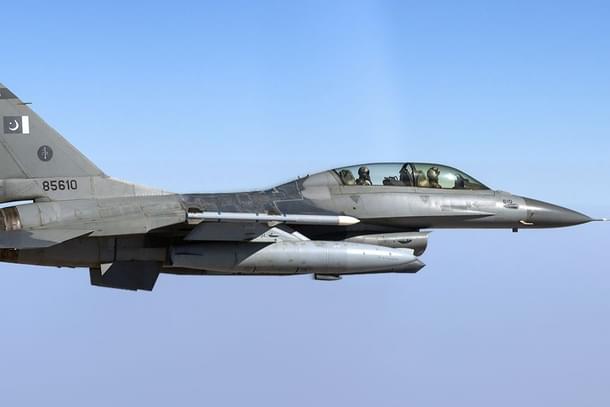Defence
Four Years Of 'Swift Retort': How Pakistan Turned Its Failed Counter Strike On India After Balakot Into A 'Victory'
Ujjwal Shrotryia
Feb 27, 2023, 06:43 PM | Updated 10:25 PM IST
Save & read from anywhere!
Bookmark stories for easy access on any device or the Swarajya app.


On 26 February 2019, Indian Air Force (IAF) launched an airstrike on a Pakistani Terrorist training camp at Balakot in Khyber Pakhtunkhwa in retaliation for a suicide bombing on a Central Reserve Police Forces (CRPF) bus, killing more than 40 soldiers.
The Pakistan Air Force (PAF) launched a counter-strike of their own, the very next day, which was four years ago (27 February 2019) on this day.
The performance of the Pakistan Air Force in the counter-strike, just like that of Pakistan's economy in recent years, was unimpressive.
During the short aerial encounter, Indian Air Force shot a Pakistani F-16 while a vintage IAF Mig-21 was downed by the PAF.

IAF’s Mig-21 pilot Wing Commander Abhinandan Varthaman was taken prisoner by the Pakistani Army but was later released when India threatened further escalation.
PAF, however, claims that it shot down one more Indian fighter jet — a Su-30MKI. As is the case with most of its claims, including the assertion that IAF hit trees and crows in Balakot, Pakistan has failed to back this claim up with proof.
While it was forced to abandon its strike mission against targets in India, the PAF claimed that it had made a conscious decision not to attack any military target.
The then Director General Inter Service Public Relations (ISPR), the propaganda wing of the Pakistan Army, Maj Gen Asif Ghafoor said one of the targets initially picked was a military administrative complex, however, the PAF command decided against hitting it.
“As a result of engaging our targets, no human life was affected. Staying within our jurisdiction, six targets were locked. And we carried out the strike,” he added. He further said the objective of the strikes was to show “we have the capacity and the will to respond, but we deliberately avoided the escalation path”.
However, as the IAF has explained in the past, the PAF was surprised with the Indian alertness and response and decided to abandon the strike.
Experts have said that the Pakistani pilots were forced to abandon their payload due to swift response by the IAF.
The IAF had scrambled Mig-21 fighters as soon as they saw Pakistani jets heading towards the Line of Control. The IAF also had Su-30 MKIs and Mirage 2000 in air at the same time.
In Pakistan, the strike was glorified as technological advantage over IAF.
They created the myth and cemented it through, conferring of gallantry awards to their pilots for their supposed bravery during the Swift Retort Operation.
Wing Commander Hassan Siddiqui and Nauman Ali Khan of the PAF were awarded Tamgha-e-Jurat and Sitara-e-Jurat respectively for the successful shooting down of Mig-21. Both Wing Commanders were celebrated as an epitome of bravery and were hailed as Pakistan’s hero.
Moreover, Pakistan opened a museum in Karachi to display the wreckage of Mig-21 which was shot down in an aerial encounter.
The museum even had a life-sized statue of Wing Commander Abhinandan Varthaman with his iconic moustache.
Pakistan is now working on a movie named “Aasman Bolay Ga”, which will also be released in Mid-2023, celebrating the "success" of the PAF in the counter strike.
The movie will turn the myths created around the counter strike and those who participated in it into a visual form, making the propaganda easy to disseminate.
Staff Writer at Swarajya. Writes on Indian Military and Defence.




